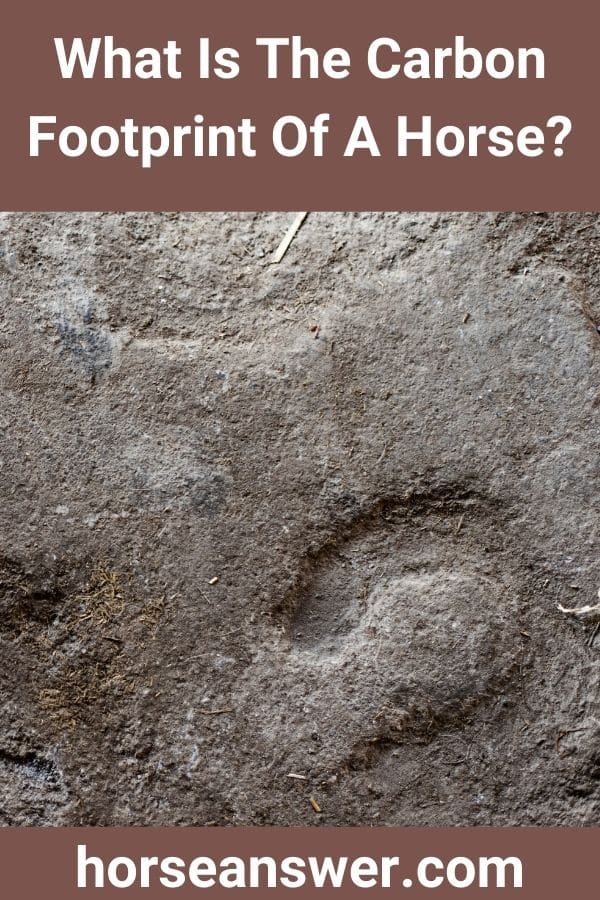What Is The Carbon Footprint Of A Horse? (Explained!)
I’ve recently become a lot more eco-conscious about a lot of things.
How I eat, how I travel, I’ve just been looking at my life and breaking down my own carbon footprint.
It occurred to me as I was going through the things in my life that I’d never considered the carbon footprint of my horses.
I never thought of them in that way, but they obviously must have one.
I decided to do some research and try and find out what it might be.
So, what is the carbon footprint of a horse?
The carbon footprint of a horse is considerably less than many other farm animals. Because they are not ruminants, they produce far less methane than cows or goats. Doing anything has a certain amount of carbon footprint, and keeping horses requires a lot of hay, water and travel.
It’s very hard to put an exact number on it, given that different people will keep their horses in different ways.
Defining a numeric value for the carbon footprint of anything involves a lot of calculation, but you can rest assured that there are a number of things you can do to reduce your horse’s carbon footprint.
Do horses emit greenhouse gases?
Horses do emit some amount of greenhouse gas.
The main concern with livestock and farm animals has been the amount of methane they produce, but I will get into that later.
Horses themselves don’t necessarily emit an especially large amount of carbon dioxide as a result of respiration, but they do leave a fair amount in their wake.
Horse dung, for example, contains a lot of nitrogen and organic matter, and paddocks can produce a fair amount of greenhouses like carbon dioxide but also nitrous oxide and some small amounts of methane.
There have been some challenges with collecting data on just how much is released, but clearly horse paddocks do leave a fairly large carbon footprint.
That said, horses are still much better than a cow or a car.
Do horses produce less methane than cows?
The big point that many focus on with this question is methane.
Cows have long been the subject of environmental scrutiny for a lot of reasons, but one in particular is the methane production.
Cows are ruminants, meaning that the largest pouch of their stomach is called a rumen.
Ruminants digest food by chewing it, swallowing it, regurgitating it and then chewing it up some more.
A lovely image, I know, but the point is that their complex digestive system and extra stomachs means that they release a lot of methane as a result of digestion.
One study in France showed that cattle produce around 90% of the methane in the country.
Horses produced only 1.5%.
So, that gives you a good idea of just how much difference there is between cows and horses.
That’s not to say that horses do not have a form of carbon footprint, but it is massively reduced when compared with cattle and other ruminants.
That said, horses do affect the environment in a number of ways.
How do horses affect the environment?
In many ways, horses actually have a positive effect on the environment.
They can help in the preservation of grassland, by preventing overgrazing and giving the grass a natural trim.
While horses graze, they continually rebuild the world around them.
They are also much less damaging to an environment than a car, when used for transport.
They don’t damage paths or roads, and are safer for pedestrians.
However, they can have a negative effect on the environment as well. For most who are just keeping a couple of horses on a homestead, they will not have a great effect on their environment.
However, if their manure is not properly cleaned, it can have a negative effect and cause damage.
The main problems come from bigger paddocks, so as long as you keep yours well maintained and make sure to compost dung, your horses will not have a huge effect.
How to reduce carbon footprint of a horse?
One of the most important things you can do is use trough watering.
If you give your horses access to a natural water source, they can have a negative effect on it in a few ways.
They can overdrink and even break the banks with their hooves.
Trough watering is really important.
Other than that, think about the feed, bedding and anything else you need to buy regularly for your horse.
The biggest carbon footprint of owning a horse is in the production and transportation of its feed, so if you can produce your own hay, that’s a great option.
If not, just ensure you buy materials from responsible, reputable providers.
So, horses do not, have no effect on the environment.
It’s reduced in many ways compared with other similar animals, but overall, they will have an effect.
Everything does, after all, to some degree.
There are ways you can think about reducing your carbon ‘hoofprint’, and if you are keeping horses and want to reduce your overall footprint, you can also think about other areas of your life where you could reduce emissions.
